|
Elmira, New York, has long been a major soaring locale, both for full-size and radio
controlled model aircraft. This 1953 article on the soaring nationals held there contains a very familiar
name to anyone who followed the 'Gossamer' series of human-powered aircraft in the the 1970s and 80s -
Paul MacCready. The propellers of the Condor
and Albatross used propellers built up of spruce and balsa, and covered with Monokote. His company,
AeroVironment, is still in operation creating breakthrough
technology for aircraft of many types. Paul won the title of National Soaring Champion that year (his third time).
See 15th National
Soaring Contest in the December 1948 Air Trails, the
20th National Soaring Contest
in November 1953 Air Trails and the
21st National Soaring Contest in the December
1954 Air Trails.
Elmira's Greatest Soaring Nationals
All Photos by Bernie Schoenfield
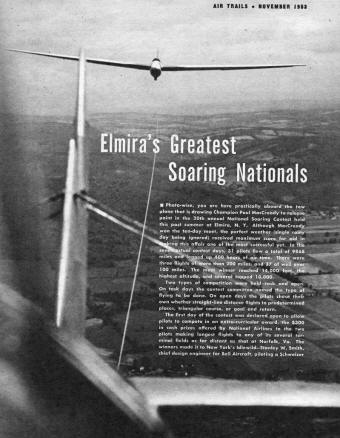
Photo-wise, you are here practically aboard the tow plane that is drawing Champion
Paul MacCready to release point in the 20th annual National Soaring Contest held this past summer at
Elmira, N. Y. Although MacCready won the ten-da meet, the perfect weather (single rainy day being ignored)
received maximum score for aid in making this affair one of the most successful yet. In the seven actual
contest das, 31 pilots flew a total of 9868 miles and logged up 400 hours of air time. There were three
flights of more than 200 miles, and 37 of well over 100 miles. The meet winner reached 14,000 feet,
the highest altitude, and several topped 10,000.
Two types of competition were held - task and open. On task days the contest committee named the
type of flying to be done. On open days the pilots chose their own whether straight-line distance flights
to predetermined places, triangular course, or goal and return.
The first day of the contest was declared open to allow pilots to compete in an extra-curricular
award, the $300 in cash prized offered by National Airlines t the two pilots making longest flights
to any of its several terminal fields as far distant as that at Norfolk, Va. The winners made it tot
New York's Idlewild-Stanley W. Smith, chief design engineer for Bell Aircraft, piloting a Schweizer
1-21, and Cmdr. H.C.N. "Nick" Goodhart of the British Royal Navy on detached service in Washington,
in an ancient surplus Laister-Kauffman LK-10A. Stephen J. Bennis also landed at Idlewild in Schweizer
1-23D. The distance from Elmira is 191 miles.

Under tow with a biplane.
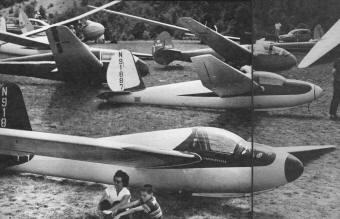
Sailplanes on flight line waiting for their turn to take off. Nearest ship is Larry
Gehrlein, Sr.'s 1-23, with Paul MacCready's 1-23D the next.
A task event which made the boys really push for their points was "one-and-a-half" goal and return
to Norwich, N. Y.-Elmira-Norwich-Elmira-Norwich. MacCready was the only one who completed that shuttle
trip. Chief mystery of the day was how Bill Beuby of Tulsa, Okla., spent his time - he covered49 miles
in a little over 7 hours, flying a German Weithe sailplane.
Most interesting event was the triangle course race whose points were at Elmira, Ithaca and Oswego.
The 85-mile course had to be flown twice with final landing at the contest site, Harris Hill. MacCready
was the winner of the day, with an almost completed second lap. A goal flight of 150 miles to Rochester
and back was almost made by Paul Schweizer, who landed at nearby Corning, N. Y. That same day Bill Beuby,
no longer seeming to fight a delaying action, flew 128 miles to Chippewa, Canada.
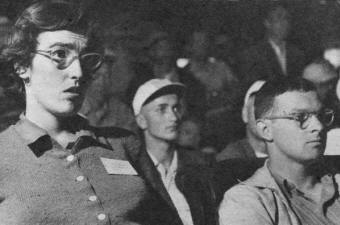
Two champions: Left is Betsy Woodward, who retained her women's title and whose best
flight was 171 miles. The studious looking gent in glasses is the National Soaring champion Paul MacCready,
Jr.
Last day of the meet was pilot's choice, with some electing Utica and return as their worthy goal.
Utica was reached by MacCready, but he could not make it back; his distance was 105 miles. Bill Coverdale
got 97 miles, landing at Brookfield, N. Y., Paul Schweizer 96 miles (Waterville, N. Y.) and Steve Bennis
82 miles (Unadilla Falls, N. Y.).

Graceful German Weihe flown by Bill Beuby, engineer at Douglas's Tulsa division.
In this ship he crossed Canadian border in 1st international soaring flight from Elmira. Ship owned
by Eastern Airlines' Capt. Shelley Charles.
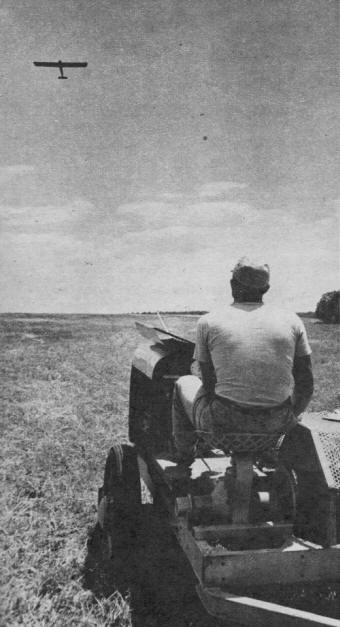
A glider is gaining altitude on winch tow. This method was not used for contest flights,
but demonstrated to show different types of launching.
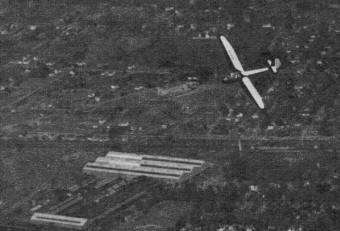
Yes, gliders do fly over cities. Here's Dale Gustin's Pratt-Read circling in a thermal
over the industrial section of Elmira.
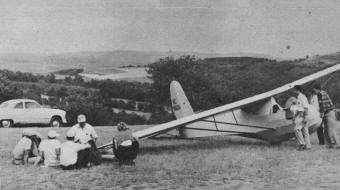
Time out for a bit of ground flying. A group of pilots and crew in front of a Schweizer
1-19 utility glider indulge in a bull session while waiting for thermals to pop. Several 1-19s were
in the contest, one flown by Larry Gehrlein, Jr. age 17, a Silver "C" pilot.
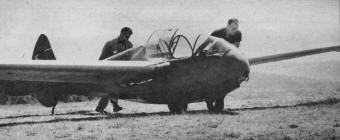
British Royal Navy Cmdr. Nick Goodhart (rt.),' assisted 'by Al Schmid of Philadelphia
Glider Council lead the LK to take-off line in this ship, Goodhart reached Idlewild field.
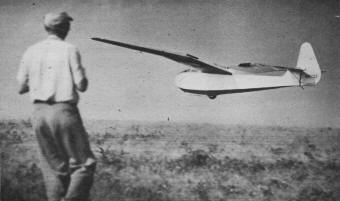
"Whatsit" was the name of the 15-year-old Martin-Jensen sailplane flown by Emil Lehecke.
On the first day of the meet, he soared the ancient warrior 158 miles to Morristown, N. J.
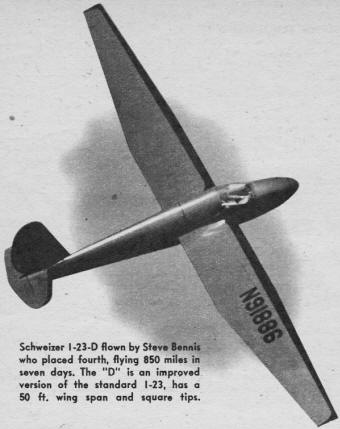
Schweizer 1-23-D flown by Steve Bennis who placed fourth, flying 850 miles in seven
days. The "D" is an improved version of the standard 1-23, has a 50 ft. wing span and square tips.
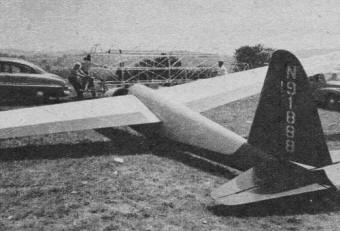
Howard Burr's 1-24 based on Schweizer 1-23 design. Wings are 55 ft. in span; the
nose is extended 10 1/2", different rudder.
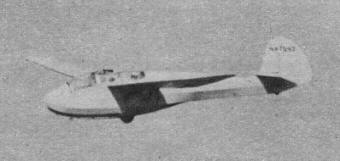
TG-2 owned by Vultures Inc. glider club of Buffalo, N. Y. Eight clubs competed at
Elmira for the Donald W. Douglas Trophy.
Although MacCready assumed and kept the lead from the first, he had to fight for every inch of it.
Smith, Schweizer and Bennis took turns being hard at his heels, and second, third and fourth positions
changed frequently. MacCready's superb meteorological know-how added to his soaring skill earned him
the victory as National Soaring Champion - the third time he has gained the honor. He was awarded the
Richard C. duPont Memorial Trophy and a score of cash prizes. Stanly Smith took second place, Paul Schweizer
third, and Stephen Bennis fourth.
The Donald W. Douglas Championship Soaring Trophy was won by the Metropolitan Airhoppers Soaring
Association represented at the contest by Stephen J. Bennis, East Orange, N. J., Emil Lehecka of Long
Island City, NY., and Theodore Pfeiffer of Ridgewood, N. Y. Betsy Woodward, Riderville, Md., the only
woman contestant, retained the women's championship.
The contest was organized by Elmira Area Soaring Corp. and sponsored by Soaring
Society of America.
Posted December 6, 2014
|



